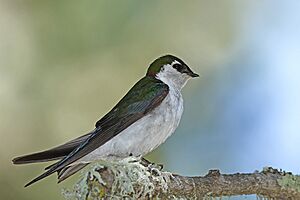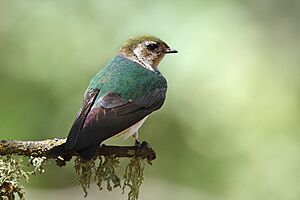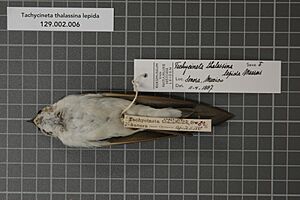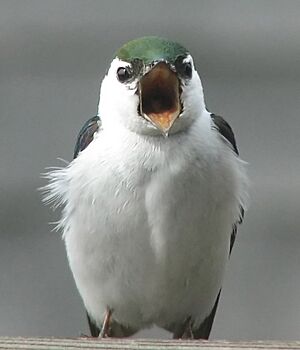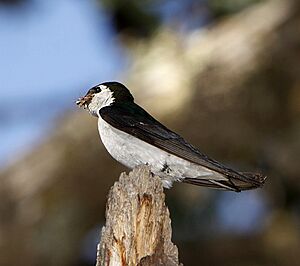Violet-green swallow facts for kids
Quick facts for kids Violet-green swallow |
|
|---|---|
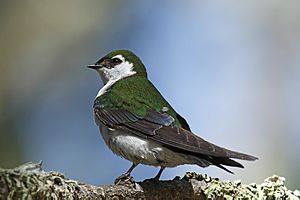 |
|
| Male in California, United States | |
 |
|
| Female in California, United States | |
| Conservation status | |
| Scientific classification | |
| Genus: |
Tachycineta
|
| Species: |
thalassina
|
| Subspecies | |
|
|
 |
|
| Green : resident area Yellow : breeding area Blue : nonbreeding area |
|
The violet-green swallow (Tachycineta thalassina) is a small North American bird. It belongs to the swallow family. These birds catch and eat insects while flying. They live along the west coast from Alaska to Mexico. Their range also goes east to Montana and Texas.
Violet-green swallows look a lot like the tree swallow. You can tell them apart by the white patches on their rump. These patches seem to separate their green back from their purple tail. Violet-green swallows nest in holes or cracks. They use tree holes in deciduous and coniferous forests. They also nest in cracks on large cliffs.
Contents
- About the Violet-Green Swallow
- Swallow Family Tree (Taxonomy)
- Where Violet-Green Swallows Live (Habitat)
- Where They Are Found (Distribution)
- Violet-Green Swallow Behavior
- See also
About the Violet-Green Swallow
Swallows have a special body shape. This shape helps them catch insects while flying. They have long, pointed wings and a slim body. The violet-green swallow is a good example.
This swallow is about 5¼ inches (13 cm) long. It looks a bit shorter and more compact than other swallows. It looks most like the North American tree swallow. But you can tell them apart by their shorter wings and different colors.
Colors of the Violet-Green Swallow
The violet-green swallow gets its name from its colors. Its head and back are glossy green. It also has hints of purple on its neck, rump, and upper tail. The rest of its wing is grayish-bronze.
Like other swallows, its belly is white. But the white also goes onto its rump, forming side-patches. These patches almost meet at the base of the tail. When the bird flies, these white patches can look like one long stripe. White also spreads onto its cheeks, partly around its eye.
The notch in the violet-green swallow's tail is not as deep as the tree swallow's. But it is deeper than the cliff swallow's tail, which is quite flat.
Male and female violet-green swallows look very similar. Males just have brighter colors. Females have less noticeable white cheeks. Their heads are more bronze than green.
Young swallows (juveniles) are harder to identify. They have duller colors. Like other young swallows, they are white below and grayish-brown above. But you can often spot them by their gradual color change. They also have visible, though smaller, white cheek patches.
Measurements of the Swallow
| Male | Female | |
|---|---|---|
| Bill length (mm) | 5.1 | 5.2 |
| Wing length (mm) | 113.9 | 107.9 |
| Tail length (mm) | 46.0 | 43.7 |
| Tarsal length (mm) | 11.7 | 11.8 |
| Longest toe (mm) | 13.2 | 13.3 |
| Mass (g) | 14.4 | 13.9 |
| Wingspan | 10.6 in (27 cm) | 10.6 in (27 cm) |
Swallow Family Tree (Taxonomy)
Swallows are passerine birds. They belong to the family called Hirundinidae. This family is divided into two main groups. One group is Pseudochelidoninae, which has two types of river martins. The other group is Hirundininae, which includes all other martins and swallows.
The violet-green swallow is part of the Hirundininae group. It is one of nine species of New World tree swallows. These are all in the genus Tachycineta. This group is considered the closest relatives to all other New World swallows.
Violet-green swallows are important in the Tachycineta group. This is because they live in a large area. They are also one of only two species that breed in North America. The Tachycineta genus is split into North and South American groups.
The violet-green swallow is in the North American group. This group also includes the North American tree swallow (T. bicolor). It also has the golden swallow (T. euchrysea) from Hispaniola and Jamaica. And it includes the Bahama swallow (T. cyaneoviridis). Scientists use different ways to study their family tree. This means the exact order of their closest relatives can sometimes change. But we know the violet-green swallow's place in its genus very well.
Violet-Green Swallow Subspecies
Violet-green swallows have three subspecies. These are T. t. thalassina, T. t. brachyptera and T. t. lepida. They differ in where they breed and their wing length.
- T. t. thalassina has slightly longer wings. It breeds as far north as Alaska.
- T. t. brachyptera has shorter wings. It breeds further south in California and Mexico.
- Not all scientists agree that T. t. lepida is a separate subspecies. There is little information to tell it apart from the others.
Hybridization (Mixing Species)
Hybridization happens when two different species breed. It is rare, but it has been seen in swallows. There have been a few cases with violet-green swallows. They have been seen breeding with tree swallows and barn swallows. However, no young birds were seen from these pairings.
In 2000, a swallow in British Columbia, Canada, had unusual feathers. This suggested it might be a mix of a violet-green and cliff swallow. But these events are very rare. Not much research has been done on swallow hybridization.
Where Violet-Green Swallows Live (Habitat)
The places where violet-green swallows live can change. It depends on their location and how high up they are. You can find these birds in deciduous, coniferous, and mixed forests. They also live in canyons and near large cliffs.
Their breeding and non-breeding habitats are similar. But breeding areas are usually at lower elevations. Violet-green swallows have also been seen nesting around buildings in towns.
Where They Are Found (Distribution)
Violet-green swallows mostly live in the western parts of North America. It is rare to see them in the east. Their full range goes from central Alaska down to Mexico.
They live along the west coast of Alaska, British Columbia, and the United States. Their range also goes east into southwestern Alberta, Montana, the Dakotas, and Texas. They breed across almost their entire range. But in winter, they mostly stay in Mexico.
Violet-Green Swallow Behavior
How They Communicate (Vocalizations)
We still have a lot to learn about how violet-green swallows make sounds. For example, we don't know much about their alarm calls. We also don't know how their calls change throughout the day.
What we do know is that they have two main types of calls. These are the chee-chee calls and twitter calls.
| Chee-chee calls | Twitter calls | |
|---|---|---|
| Syllables | One or two syllables | One syllable |
| Frequency (kHz) | 2.5 - ≥7.0 | 2.0 – 6.5 |
| Duration (ms) | 165 | 125 |
| Repetition | Pairs of series | No clear pattern |
| Intervals (ms) | 85 - 165 | Unknown |
Chee-chee Calls
You hear this call most often when swallows interact. This happens when they are looking for food or chasing each other. It also happens when they approach a nesting spot.
Groups of swallows make chee-chee calls. This suggests the calls help them stay together. Young swallows also make this call when they want food from an adult. This means it helps parents recognize their young.
Twitter Calls
Twitter calls are usually heard during courtship displays. They also happen when birds set up new territories. Twitter calls are only heard when the birds are flying. This could be a male with a female. Or it could be during short fights over territory. Sometimes, the two calls mix. But scientists don't fully understand why.
What They Eat (Diet)
Like other swallows, violet-green swallows are special insectivores. They catch and eat their prey while flying. They are known to fly higher in the sky to feed than most other swallows.
Scientists have looked at what's inside their stomachs. They found many different insects. These include ants, beetles, and flies. They also eat other arthropods like spiders. Very rarely, these birds have been seen looking for food on the ground. But this is not how they usually eat.
Reproduction and Life Cycle
Violet-green swallows usually arrive at their breeding areas weeks before they start to reproduce. Depending on the location, they mate in mid-May. Eggs are laid by early June. Then, the eggs hatch after a couple of weeks.
A female usually lays about 5 eggs, one per day. After hatching, the parents feed the young. The young birds slowly grow their feathers. After about 3 weeks, the young are ready to leave the nest. Most pairs breed once per season. But sometimes, a second group of young is raised.
Nesting Sites
Violet-green swallows are secondary cavity nesters. This means they nest in natural holes. Or they use nests that other animals have used before. Some pairs even take over nests from other species.
Most violet-green swallow nests are in tree holes. These holes are often made by other animals. They also nest in cracks on large cliffs. Because they need big trees, forest management can affect them. Besides natural holes, they also use human-made nest boxes. Pairs usually breed in their own nests. But on cliffs, many nests can be found together in large colonies.
Egg-Dumping (Interspecific)
Violet-green swallows have been seen interacting with other bird species. This includes western bluebirds. One time, a violet-green swallow laid an egg in a bluebird's active nest box. The male bluebird tried to chase the swallow away. But the female bluebird didn't seem to mind.
It looked like the bluebirds allowed the swallow to lay its egg. But the next day, the new egg was found broken below the nest. This behavior suggests that if a female swallow can't get to her own nest, she might lay her egg in another species' nest.
Protecting Their Young (Intraspecific Paternity-Defence)
Male violet-green swallows spend more time guarding their mate than their nest. This is different from tree swallows. This behavior shows that male swallows compete more for mates than for nesting spots.
Working Together (Interspecific Cooperation)
There are stories of violet-green swallows working with other species. From 1981 to 1982, three swallow pairs were seen sharing nest boxes with western bluebirds. These swallows protected the nest. They also removed waste from the boxes. They even fed the bluebird fledglings. The adult bluebirds did not try to stop them.
Even though it was a small study, young birds survived better when swallows helped. It is thought that the swallows benefit by taking over the nest box. They use it after the bluebirds leave.
Competition for Nests (Interspecific Competition)
Violet-green swallows sometimes work with other species. But they also compete for nesting spots. In 1974, a fight was seen between mountain chickadees and violet-green swallows. The swallows tried to take over a nest where chickadees had young.
After many aerial battles, the chickadees won. They successfully defended their nest. The same observer saw similar fights with hairy woodpeckers. The woodpeckers also won. These other species live in the area all year. This means they get to choose nesting spots first. Violet-green swallows arrive in summer and breed later. So, there might not be enough good nesting spots left. This can lead to competition. Similar fights have been seen between acorn woodpeckers and violet-green swallows.
Torpor (Temporary Hibernation)
Some birds, including swallows, can enter a state called torpor. This is like a mini-hibernation during cold weather. Their body temperature and metabolic rate drop.
The first time this was seen in violet-green swallows was in 1965. It happened near Death Valley National Monument in Saratoga Springs, California. Observers found three "dead" birds on a sand dune. This was after a cold, windy night.
When they looked closer, the swallows moved a little. They opened their eyes. But they did not struggle when handled. Their appearance, like their head position and fluffed feathers, was like other birds in torpor. Even without thermometers, it was clear they were very cold. After about 45 minutes, as the sun rose, the swallows awkwardly flew away. This showed their torpor had ended.
Controlling Parasites (Ectoparasite Control)
Sunbathing
Violet-green swallows can get very cold during torpor. But they have also been seen acting like they are very hot when sunbathing. They position their wings and tail in a certain way. They seem to be in a trance. Sometimes, they even lose their balance.
Research shows that warming their feathers while sunbathing can help control ectoparasites. These are parasites that live on the outside of their bodies. Sunbathing for violet-green swallows is short. It depends on the air temperature and wind. But it usually happens when they have more parasites, near the end of nesting season.
See also
 In Spanish: Golondrina verdemar para niños
In Spanish: Golondrina verdemar para niños




